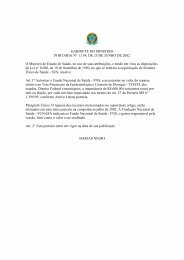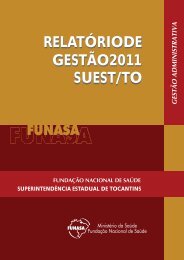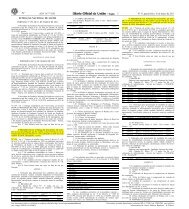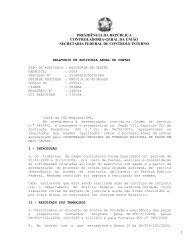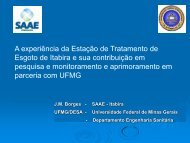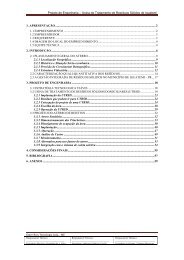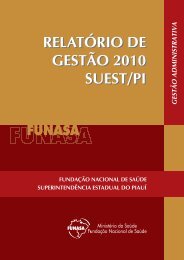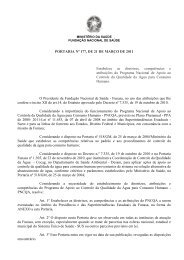Tratamiento de aguas residuales municipales - Funasa
Tratamiento de aguas residuales municipales - Funasa
Tratamiento de aguas residuales municipales - Funasa
Create successful ePaper yourself
Turn your PDF publications into a flip-book with our unique Google optimized e-Paper software.
<strong>Tratamiento</strong> <strong>de</strong> <strong>aguas</strong> <strong>residuales</strong> <strong>municipales</strong>:<br />
evolución <strong>de</strong> la tecnología en el contexto <strong>de</strong><br />
América Latina<br />
Adalberto Noyola<br />
Instituto <strong>de</strong> Ingeniería<br />
Universidad Nacional Autónoma <strong>de</strong> México (UNAM)<br />
IV Seminário Internacional <strong>de</strong> Engenharia <strong>de</strong> Saú<strong>de</strong> Pública<br />
Belo Horizonte, Brasil<br />
18 a 21 <strong>de</strong> marzo 2013
El Saneamiento en América Latina<br />
Procesos <strong>de</strong> tratamiento <strong>de</strong> <strong>aguas</strong> <strong>residuales</strong> en América Latina<br />
<strong>Tratamiento</strong> <strong>de</strong> <strong>aguas</strong> <strong>residuales</strong> y cambio climático<br />
La tecnología para el tratamiento <strong>de</strong> <strong>aguas</strong> <strong>residuales</strong> <strong>municipales</strong><br />
Comentarios finales<br />
Contenido
Saneamiento en<br />
América Latina
América Latina y el Caribe (ALyC)<br />
563 millones <strong>de</strong> habitantes (8.5% pob. mundial)<br />
PIB extremos<br />
Agua potable para 85 % <strong>de</strong> su población (84 millones carentes)<br />
Saneamiento para 78 % <strong>de</strong> su población (124 millones carentes)<br />
<strong>Tratamiento</strong> <strong>de</strong> <strong>aguas</strong> <strong>residuales</strong> <strong>de</strong>l or<strong>de</strong>n <strong>de</strong>l 20%<br />
El 54% <strong>de</strong> los residuos sólidos <strong>municipales</strong> van a relleno sanitario.<br />
El 23 % se dispone en tira<strong>de</strong>ros no controlados
120<br />
100<br />
80<br />
60<br />
40<br />
20<br />
Mortalidad infantil, agua y saneamiento en AL<br />
0<br />
CAN<br />
USA<br />
CUB<br />
CHI<br />
COR<br />
URU<br />
VEN<br />
ARG<br />
PAN<br />
COL<br />
MEX<br />
DOM<br />
HON<br />
ECU<br />
ELS<br />
BRA<br />
GUT<br />
NIC<br />
CAN USA CUB CHI COR URU VEN ARG PAN COL MEX DOM HON ECU ELS BRA GUT NIC PER HAI<br />
Mortalidad infantil 7 8 10 14 14 20 23 24 25 28 34 42 43 44 44 47 48 52 55 86<br />
Acceso al agua 100 100 91 91 100 89 79 65 84 75 83 73 77 55 53 69 67 62 66 39<br />
Acceso a saneamiento 100 100 94 93 94 94 69 84 93 83 72 90 70 58 68 85 79 76 74 26<br />
PER<br />
HAI<br />
Mortalidad infantil<br />
Acceso al agua<br />
Acceso a saneamiento
El Saneamiento en ALyC<br />
Elementos técnicos <strong>de</strong> diagnóstico en <strong>aguas</strong> <strong>residuales</strong><br />
Saneamiento para el 78% <strong>de</strong> la población<br />
48% alcantarillado<br />
30% letrinas o tanques sépticos<br />
Tecnologías convencionales en su gran mayoría<br />
Lagunas <strong>de</strong> estabilización (++++)<br />
Lodos activados (+)<br />
Resistencia a la aceptación <strong>de</strong> tecnologías adaptadas<br />
Medio conservador<br />
Dominio <strong>de</strong> empresas transnacionales
Los ODM y el Saneamiento<br />
Objetivos <strong>de</strong> Desarrollo <strong>de</strong>l Milenio (ONU, 2000)<br />
Reducir a la mitad la proporción <strong>de</strong> personas sin acceso al agua<br />
potable y a condiciones sanitarias a<strong>de</strong>cuadas en 2015 (Objetivo 7,<br />
meta 10)<br />
Alcanzar en 2020 un incremento significativo en la calidad <strong>de</strong> vida<br />
<strong>de</strong> al menos 100 millones <strong>de</strong> habitantes en áreas marginadas<br />
(Objetivo 7, meta 11)<br />
Montos <strong>de</strong> inversión requeridos para cumplir la meta 10 en<br />
ALyC<br />
800 millones USD anuales para agua potable<br />
1,500 millones USD anuales para saneamiento
Procesos <strong>de</strong> tratamiento <strong>de</strong><br />
<strong>aguas</strong> <strong>residuales</strong> <strong>municipales</strong> en<br />
América Latina
Inventario <strong>de</strong> Tecnologías <strong>de</strong> <strong>Tratamiento</strong> en AL y C:<br />
Metodología<br />
Recopilación <strong>de</strong> información a<br />
cargo <strong>de</strong> un consultor en cada país<br />
seleccionado.<br />
Información documental publicada<br />
por las <strong>de</strong>pen<strong>de</strong>ncias, entida<strong>de</strong>s y<br />
organismos operadores.<br />
Inventario <strong>de</strong> información para una<br />
muestra <strong>de</strong> PTAR /país, <strong>de</strong> acuerdo<br />
con:<br />
- Categorización <strong>de</strong> ciuda<strong>de</strong>s por tamaño<br />
<strong>de</strong> población.<br />
-Tipo <strong>de</strong> formato <strong>de</strong> información a aplicar:<br />
a) Formato general<br />
b) Formatos específicos:<br />
- Calidad <strong>de</strong>l agua residual<br />
-Lodos, biosólidos y residuos sólidos<br />
- Emisiones y control <strong>de</strong> olores<br />
- Costos
Procesos aplicados en el tratamiento <strong>de</strong> <strong>aguas</strong><br />
<strong>residuales</strong> <strong>municipales</strong> en 6 países seleccionados<br />
Distribución por tecnologías<br />
No. of installed technologies<br />
1200<br />
1000<br />
800<br />
600<br />
400<br />
200<br />
0<br />
1106<br />
(38%)*<br />
760<br />
(26%)*<br />
493<br />
(17%)*<br />
140 137 125<br />
Technologies<br />
Las 3 tecnologías más usadas<br />
representan el 80% <strong>de</strong>l total <strong>de</strong> la muestra<br />
México: 1684 PTAR<br />
Brasil: 854 PTAR<br />
Chile: 178 PTAR<br />
Colombia: 141 PTAR<br />
Guatemala:43 PTAR<br />
República: Dominicana: 33 PTAR<br />
TOTAL: 2933 PTAR*<br />
(tamaño muestra: 2734 PTAR)<br />
84<br />
54<br />
18 10 6<br />
Noyola et al. (2012)<br />
• The septic tank was not consi<strong>de</strong>red as technology for the treatment<br />
• * 199 WWTP that reported combined processes (two technologies)<br />
were counted in<strong>de</strong>pen<strong>de</strong>ntly.
Porcentage (%)<br />
Procesos aplicados en el tratamiento <strong>de</strong> <strong>aguas</strong><br />
<strong>residuales</strong> <strong>municipales</strong> en 6 países seleccionados<br />
Distribución por países<br />
70<br />
60<br />
50<br />
40<br />
30<br />
20<br />
10<br />
0<br />
Stabilization pond<br />
Activated sludge<br />
UASB<br />
Wetland<br />
Trickling filter<br />
Aerated pond<br />
Stabilization pond<br />
Activated sludge<br />
UASB<br />
Wetland<br />
Trickling filter<br />
Aerated pond<br />
Stabilization pond<br />
Activated sludge<br />
UASB<br />
Wetland<br />
Trickling filter<br />
Aerated pond<br />
Stabilization pond<br />
Activated sludge<br />
UASB<br />
Wetland<br />
Trickling filter<br />
Aerated pond<br />
Stabilization pond<br />
Activated sludge<br />
UASB<br />
Wetland<br />
Trickling filter<br />
Aerated pond<br />
Stabilization pond<br />
Activated sludge<br />
UASB<br />
Wetland<br />
Trickling filter<br />
Aerated pond<br />
Brazil Chile Colombia Guatemala Dominican Republic Mexico<br />
Noyola et al. (2012)
Procesos aplicados en el tratamiento <strong>de</strong> <strong>aguas</strong><br />
<strong>residuales</strong> <strong>municipales</strong> en 6 países seleccionados<br />
Flujo <strong>de</strong> diseño acumulado por tecnología<br />
Accumulated treated flow (m 3 /s)<br />
120<br />
100<br />
80<br />
60<br />
40<br />
20<br />
0<br />
104,1<br />
(58%)<br />
27,1<br />
(15%)<br />
16,1<br />
(9%)<br />
14,2<br />
Technologies<br />
10,3<br />
6,4<br />
0,9 0,7 0,4 0,4 0,3<br />
Noyola et al. (2012)
Distribución <strong>de</strong> PTAR por tamaño<br />
Brasil: 62% (0.1 a 25 L/s)<br />
42% (0.1 a 5 L/s)<br />
México: 76% (0.1 a 25 L/s)<br />
61% (0.1 a 5 L/s)
<strong>Tratamiento</strong> <strong>de</strong> <strong>aguas</strong><br />
<strong>residuales</strong> y Cambio Climático
• Los tratamientos <strong>de</strong> <strong>aguas</strong> <strong>residuales</strong> generan impactos ambientales y<br />
contribuyen a la emisión <strong>de</strong> Gases <strong>de</strong> Efecto Inverna<strong>de</strong>ro (GEI).<br />
-Metano (CH4): Dependiendo <strong>de</strong> la tecnología utilizada<br />
y su operación. Se estima que el metano producido por<br />
el manejo <strong>de</strong> <strong>aguas</strong> <strong>residuales</strong> <strong>municipales</strong> contribuye<br />
con cerca <strong>de</strong>l 7% <strong>de</strong> las fuentes <strong>de</strong> emisión <strong>de</strong> metano<br />
global.<br />
- Dióxido <strong>de</strong> Carbono (CO2) : Solo lo producido por el<br />
consumo eléctrico <strong>de</strong> las plantas.<br />
• La selección <strong>de</strong> tecnologías <strong>de</strong> tratamiento <strong>de</strong> <strong>aguas</strong> <strong>residuales</strong> <strong>de</strong>be<br />
abordar el problema con un enfoque integral.
Gases <strong>de</strong> efecto inverna<strong>de</strong>ro<br />
Gas <strong>de</strong> efecto<br />
inverna<strong>de</strong>ro<br />
CO 2<br />
CH 4<br />
Contribución al<br />
calentamiento global (%)<br />
60<br />
20<br />
CFC 10<br />
N 2 O 5<br />
IPCC (1996)<br />
Potencial <strong>de</strong> calentamiento global (GWP) <strong>de</strong>l metano: 21
Orígen <strong>de</strong>l metano atmosférico<br />
Fuentes <strong>de</strong> emisiones <strong>de</strong> metano Contribución (%)<br />
Producción <strong>de</strong> energía (gas natural) 26<br />
Fermentación entérica 24<br />
Cultivo <strong>de</strong> arroz 17<br />
Rellenos sanitarios 11 *<br />
Quemado <strong>de</strong> biomasa 8<br />
Desechos 7 *<br />
Aguas <strong>residuales</strong> <strong>municipales</strong> 7 *<br />
* Suma <strong>de</strong> residuos: 25 %<br />
IPCC (1994)
La tecnología para el tratamiento<br />
<strong>de</strong> <strong>aguas</strong> <strong>residuales</strong> <strong>municipales</strong>
Las Herramientas Tecnológicas<br />
El tratamiento <strong>de</strong> <strong>aguas</strong> <strong>residuales</strong><br />
Consi<strong>de</strong>randos:<br />
La materia no se <strong>de</strong>struye, solo se transforma<br />
* la inevitabilidad <strong>de</strong> los subroductos y residuos<br />
* integrar un sistema completo<br />
El mejor tren <strong>de</strong> tratamiento<br />
* con el máximo <strong>de</strong> economía y el mínimo <strong>de</strong><br />
complejidad, alcanza la calidad <strong>de</strong> agua requerida<br />
Las principales causas <strong>de</strong> la ineficiencia <strong>de</strong> las plantas<br />
* Abandono por altos costos <strong>de</strong> operación<br />
* Sistema impuesto al organismo responsable <strong>de</strong> la<br />
operación<br />
* Decisiones <strong>de</strong> corto plazo
Principales procesos <strong>de</strong> tratamiento biológico <strong>de</strong><br />
<strong>aguas</strong> <strong>residuales</strong><br />
AEROBIO<br />
S<br />
ANOXICOS<br />
ANAEROBIO<br />
S<br />
COMBINADO<br />
S<br />
BIOMASA<br />
SUSPENDIDA<br />
BIOMASA<br />
FIJA<br />
BIOMASA<br />
SUSPENDIDA<br />
BIOMASA<br />
FIJA<br />
BIOMASA<br />
SUSPENDIDA<br />
BIOMASA<br />
FIJA<br />
LAGUNAS FACULTATIVAS<br />
LODOS ACTIVADOS (ver recuadro)<br />
LAGUNAS AERADAS<br />
LAGUNAS DE OXIDACIÓN<br />
LAGUNAS DE ALTA TASA<br />
NITRIFICACIÓN<br />
FILTRO PERCOLADOR<br />
DISCO BIOLÓGICO ROTATORIO<br />
FILTRO SUMERGIDO<br />
LECHO FLUIDIFICADO<br />
LODOS ACTIVADOS (SELECTOR)<br />
REACTOR DE LECHO DE LODOS DE<br />
FLUJO ASCENDENTE (UASB) (1)<br />
FILTRO SUMERGIDO<br />
DISCO BIOLÓGICO ROTATORIO<br />
LECHO FLUIDIFICADO<br />
LAGUNAS ANAEROBIAS<br />
CONTACTO ANAEROBIO<br />
REACTOR DE LECHO DE LODOS DE<br />
FLUJO ASCENDENTE (UASB) (1)<br />
REACTOR DE LECHO GRANULAR<br />
EXPANDIDO (EGSB) (1)<br />
FILTRO ANAEROBIO<br />
LECHO FLUIDIFICADO<br />
VARIANTES DE<br />
LODOS ACTIVADOS<br />
FLUJO PISTON<br />
COMPLETAMENTE MEZCLADO<br />
AERACIÓN EXTENDIDA<br />
AERACIÓN POR ETAPAS<br />
AERACIÓN EN DISMINUCIÓN<br />
ALTA TASA<br />
CONTACTO-ESTABILIZACIÓN<br />
OXÍGENO PURO<br />
(1) Los reactores UASB y EGSB son<br />
estrictamente sistemas <strong>de</strong> biomasa suspendida,<br />
aunque pue<strong>de</strong>n clasificarse como biomasa fija,<br />
gracias a la granulación <strong>de</strong>l lodo y su retención
Subconjuntos<br />
Tecnologías adaptadas<br />
Por <strong>de</strong>nsidad <strong>de</strong> población (urbana y rural)<br />
Por clima (zonas cálidas y templadas/frías)<br />
Por grado <strong>de</strong> mecanización<br />
Aprovechar la biodiversidad y las condiciones<br />
climatolólogicas <strong>de</strong> ALyC<br />
Procesos anaerobios y naturales
Por una tecnología más sustentable<br />
Características <strong>de</strong>seables <strong>de</strong> un proceso <strong>de</strong> tratamiento<br />
Ahorra y optimiza (menores necesida<strong>de</strong>s <strong>de</strong> insumos)<br />
Recicla, no agota (minimiza residuos y genera subproductos)<br />
Integra (sistema “sin cabos sueltos”)<br />
Perdura (esquema tecnológico - administrativo - financiero<br />
a<strong>de</strong>cuado, compatible con su entorno social y ambiental)
BIOLÓGICO ¿AEROBIO O ANAEROBIO?<br />
Debate<br />
* respuesta clara en efluentes industriales<br />
* permanece en <strong>aguas</strong> <strong>residuales</strong> <strong>municipales</strong><br />
Anaerobio<br />
* menor costo <strong>de</strong> operación<br />
(energía, lodos, complejidad)<br />
* menor calidad <strong>de</strong> agua tratada y olores<br />
Aerobio<br />
* inverso <strong>de</strong> lo anterior<br />
Complementarios en muchos casos (anaerobio + aerobio)
Flujo <strong>de</strong> energía (DQO) en los procesos biológicos<br />
100 %<br />
(DQO)<br />
materia<br />
orgánica<br />
O2<br />
anaerobia<br />
aerobia<br />
CH4 + CO2<br />
células<br />
H2O + CO2<br />
energía<br />
disipada<br />
células<br />
( 90 % )<br />
( 10 % )<br />
( 35 % )<br />
( 65 % )
FOSA SÉPTICA TANQUE IMHOFF LAGUNA ANAEROBIA<br />
DIGESTOR<br />
CONVENCIONAL<br />
FILTRO<br />
ANAEROBIO<br />
DIGESTOR COMPLETAMENTE<br />
MEZCLADO<br />
Reactores anaerobios <strong>de</strong> primera generación<br />
REACTOR TUBULAR DE<br />
PELÍCULA FIJA<br />
Reactores anaerobios <strong>de</strong> segunda generación<br />
REACTOR DE LECHO GRANULAR<br />
EXPANDIDO (EGSB) CON<br />
RECIRCULACION INTERNA<br />
CONTACTO<br />
ANAEROBIO<br />
REACTOR DE LECHO DE<br />
LODOS (UASB)<br />
REACTOR DE LECHO EXPANDIDO<br />
O FLUIDIFICADO<br />
Reactores anaerobios <strong>de</strong> tercera generación
Agua residual<br />
La diferencia anaerobia<br />
Aerobio<br />
Energía requerida<br />
1 kWh/kg DQO rem<br />
X biomasa<br />
Efluente (+)<br />
Agua residual<br />
Anaerobio<br />
Producción <strong>de</strong> biogás<br />
3 kWh/kg DQO rem<br />
1 kWh/kg DQO rem<br />
0.2X biomasa<br />
Efluente (-)
Aguas <strong>residuales</strong> <strong>municipales</strong><br />
como “sustrato”<br />
Baja concentración <strong>de</strong> materia orgánica<br />
250 a 500 mg/l <strong>de</strong> DQO<br />
Fracciones altas <strong>de</strong> sólidos suspendidos<br />
Aproximadamente 50% of DQO (150 a 300 mg/l)<br />
Temperatura <strong>de</strong> media a baja<br />
Alre<strong>de</strong>dor <strong>de</strong> 20ºC<br />
Flujo altamente variable<br />
Contenido <strong>de</strong> patógenos (y parásitos)
<strong>Tratamiento</strong> anaerobio <strong>de</strong> <strong>aguas</strong><br />
Primeros intentos:<br />
<strong>residuales</strong> <strong>municipales</strong><br />
Tanques sépticos (finales <strong>de</strong>l siglo XIX)<br />
Lagunas anaerobias<br />
Tanques Imhoff (inicio siglo XX) Lodos Activados<br />
Claridigestores (Sudáfrica, 1950´s)<br />
Reciente aparición:<br />
Reactores anaerobios <strong>de</strong> alta tasa para el tratamiento <strong>de</strong> <strong>aguas</strong><br />
<strong>residuales</strong> industriales<br />
Adaptación al tratamiento <strong>de</strong> <strong>aguas</strong> <strong>residuales</strong> <strong>municipales</strong><br />
UASB (Cali, 1983), RALF (Paraná, 1982)<br />
Aplicaciones limitadas <strong>de</strong>l FA, LE
Reactores anaerobios <strong>de</strong> alta tasa<br />
Filtro anaerobio<br />
UASB<br />
Reactores <strong>de</strong> lecho expandido y fluidizado<br />
Variaciones: Reactor híbrido, EGSB, Reactor con<br />
<strong>de</strong>flectores<br />
Características comunes:<br />
Altos tiempos <strong>de</strong> retención celular/ bajos tiempos <strong>de</strong><br />
resi<strong>de</strong>ncia hidráulico<br />
Mejor transferencia <strong>de</strong> masa
Biogás<br />
Deflector<br />
Reactor UASB<br />
vertedor<br />
Zona <strong>de</strong> sedimentación<br />
Colector <strong>de</strong> gas<br />
•Proceso anaerobio <strong>de</strong> alta tasa<br />
• No se requiere material <strong>de</strong> empaque<br />
• Arranque rápido utilizando lodo granular<br />
• No se requiere mezclado mecánico<br />
Lecho <strong>de</strong> lodos<br />
Influente
Reactor UASB en el tratamiento <strong>de</strong><br />
<strong>aguas</strong> <strong>residuales</strong> <strong>municipales</strong><br />
• Instalación compacta….<br />
• Sedimentador primario<br />
• Reactor biológico<br />
• Sedimentador secundario<br />
• Digestor <strong>de</strong> lodos<br />
• Espesador <strong>de</strong> lodos<br />
….todo en un tanque<br />
• Conservación <strong>de</strong> nutrientes (irrigación<br />
<strong>de</strong> cultivos)<br />
• Operación sencilla y económica<br />
•Sin embargo…<br />
Baja calidad <strong>de</strong>l efluente<br />
Requiere temperaturas <strong>de</strong>l agua por encima <strong>de</strong> 20 C<br />
Biogás<br />
Deflector<br />
vertedor<br />
Zona <strong>de</strong> sedimentación<br />
Colector <strong>de</strong> gas<br />
Lecho <strong>de</strong><br />
lodos<br />
Influente
Reactor UASB en el tratamiento <strong>de</strong><br />
<strong>aguas</strong> <strong>residuales</strong> <strong>municipales</strong><br />
Diseño típico <strong>de</strong>l reactor UASB para<br />
aplicación en el tratamiento <strong>de</strong> agua<br />
residual municipal<br />
•Temperatura: arriba <strong>de</strong> 20 C<br />
•TRH: 6 a 8 horas<br />
•Carga orgánica: 1.5 a 2 kg DQO/m 3 day<br />
(no es un parámetro limitante)<br />
•Altura: 5 a 6 metros<br />
•Velocidad <strong>de</strong> flujo ascen<strong>de</strong>nte: 0.6 a 0.8<br />
m/h<br />
•Puntos alimentación: 1 por cada 2 a 4 m 2<br />
Biogás<br />
Deflector<br />
Vertedor<br />
Zona <strong>de</strong> sedimentación<br />
Colector <strong>de</strong> Gas<br />
Lecho <strong>de</strong><br />
lodos<br />
Influente
Diseño convencional<br />
Colectores <strong>de</strong> gas emergentes<br />
Una fila <strong>de</strong> colectores <strong>de</strong> gas<br />
Una fila <strong>de</strong> <strong>de</strong>flectores <strong>de</strong> gas
Zona <strong>de</strong> sedimentación <strong>de</strong> menor área<br />
(mayor velocidad <strong>de</strong> flujo ascen<strong>de</strong>nte)<br />
Diseño inicial (malo)<br />
Adaptación <strong>de</strong> reactores UASB industriales<br />
Zona <strong>de</strong> lodos <strong>de</strong> mayor área<br />
(menor velocidad <strong>de</strong> flujo ascen<strong>de</strong>nte)<br />
a2<br />
a1
Zona <strong>de</strong> sedimentación <strong>de</strong> mayor área<br />
(menor velocidad <strong>de</strong> flujo ascen<strong>de</strong>nte)<br />
Zona <strong>de</strong> lodos <strong>de</strong> menor área<br />
(mayor velocidad <strong>de</strong> flujo ascen<strong>de</strong>nte)
Colectores <strong>de</strong> gas sumergidos<br />
Evacuación <strong>de</strong>l biogás a través <strong>de</strong> tubería<br />
Toda el área superficial líquida para<br />
sedimentación<br />
Problemas <strong>de</strong> obstrucción!!
Algunas necesida<strong>de</strong>s <strong>de</strong> <strong>de</strong>sarrollo tecnológico<br />
Manejo <strong>de</strong> espumas y natas<br />
Captación metano disuelto en efluente<br />
Manejo <strong>de</strong>l biogás<br />
Mejorar la distribución <strong>de</strong>l agua residual en<br />
la cama<br />
Incrementar la transferencia <strong>de</strong> masa<br />
(contacto sustrato – microorganismos)
Reactor UASB en el tratamiento <strong>de</strong><br />
<strong>aguas</strong> <strong>residuales</strong> <strong>municipales</strong><br />
Resultados típicos en la aplicación <strong>de</strong> reactores<br />
UASB para el tratamiento <strong>de</strong> agua residual<br />
municipal<br />
(Temperatura <strong>de</strong>l agua residual 20 C o más)<br />
• DBO efluente: 40 a 60 mg/l<br />
• DQO <strong>de</strong>l efluente: 120 a 160 mg/l<br />
• SST efluente: 40 a 60 mg/l<br />
• Remoción <strong>de</strong> DBO: 75 a 85%<br />
• Remoción <strong>de</strong> DQO: 70 a 80%<br />
• Remoción <strong>de</strong> Coliformes Fecales: 1 unidad log<br />
• Remoción <strong>de</strong> huevos <strong>de</strong> parásitos: hasta el 100%<br />
En muchos casos es necesario un postratamiento
Influente<br />
Área <strong>de</strong> sedimentación<br />
Dispositivo colector<br />
<strong>de</strong> biogás<br />
Area <strong>de</strong> expansión<br />
<strong>de</strong>l lodo<br />
Colectores sumergidos <strong>de</strong> gas, en dos filas Lecho <strong>de</strong> Lodos<br />
Evacuación <strong>de</strong>l biogás a través <strong>de</strong> una cámara <strong>de</strong> gas
Alimentación <strong>de</strong> agua residual por gravedad (caja <strong>de</strong> distribución)
Principales limitantes <strong>de</strong> los reactores UASB en<br />
el tratamiento <strong>de</strong> <strong>aguas</strong> <strong>residuales</strong> <strong>municipales</strong><br />
Baja calidad <strong>de</strong>l efluente ( no se alcanzan los estándares <strong>de</strong><br />
calidad <strong>de</strong>l tratamiento secundario)<br />
No hay remoción <strong>de</strong> nutrientes (N, P)<br />
La temperatura es crucial (<strong>de</strong>be estar por arriba <strong>de</strong> 20 C)<br />
Olores<br />
(Todavía) no es aceptada entre los ingenieros practicantes
Nuevos <strong>de</strong>sarrollos<br />
… permaneciendo una tecnología simple<br />
Superar la limitante <strong>de</strong> temperatura<br />
Reactor <strong>de</strong> lecho granular expandido<br />
Aumento en la transferencia <strong>de</strong> masa. Únicamente para agua<br />
residual sedimentada.<br />
Reactor <strong>de</strong> dos fases<br />
Mejoramiento <strong>de</strong> la hidrólisis en un reactor <strong>de</strong> un solo paso<br />
Control <strong>de</strong> olores y manejo <strong>de</strong>l biogás<br />
Instrumentación simple para asegurar operación y<br />
supervisión
El reúso: la nueva realidad<br />
Existe tecnología para llevar agua residual a potable<br />
Integración <strong>de</strong> trenes <strong>de</strong> tratamiento para una<br />
calidad <strong>de</strong> agua específica, en función <strong>de</strong> la <strong>de</strong>manda<br />
Evaluación económica <strong>de</strong>sfavorable ante una oferta<br />
<strong>de</strong> agua tratada, con costos reales, en sustitución <strong>de</strong><br />
agua potable subsidiada<br />
Problemática técnica, financiera y social<br />
La solución a<strong>de</strong>cuada será la que logre la máxima<br />
sustentabilidad
Trenes <strong>de</strong> tratamiento con fines <strong>de</strong> reúso<br />
<strong>de</strong> agua tratada<br />
1. Tren básico, integrado por rejilla, <strong>de</strong>sarenador, tratamiento anaerobio y<br />
<strong>de</strong>sinfección.<br />
2. Tren básico + Filtración y <strong>de</strong>sinfección.<br />
3. Tren básico + Remoción biológica <strong>de</strong> nitrógeno, filtración y <strong>de</strong>sinfección.<br />
4. Tren básico + Remoción biológica <strong>de</strong> nitrógeno, remoción química <strong>de</strong><br />
fósforo, filtración rápida y <strong>de</strong>sinfección.<br />
5. Tren básico + Remoción biológica <strong>de</strong> nitrógeno, remoción química <strong>de</strong><br />
fósforo, filtración rápida, ozonación, adsorción en carbón activado.<br />
6. Tren 5 + Ósmosis inversa y <strong>de</strong>sinfección
Riego con restricción<br />
restricciones<br />
Metanol/Biogás<br />
Riego sin restricción<br />
Carbón activado agotado a disposición final (en pilas <strong>de</strong> composteo)
Otros residuos:<br />
Material <strong>de</strong> rejillas<br />
Lodos arenosos<br />
Lodos primarios y secundarios<br />
Gases, olores<br />
para UASB: natas, espumas
Influente<br />
<strong>de</strong> agua<br />
residual<br />
<strong>Tratamiento</strong><br />
preliminar<br />
Residuos<br />
<strong>Tratamiento</strong> convencional <strong>de</strong> <strong>aguas</strong> <strong>residuales</strong><br />
<strong>Tratamiento</strong><br />
primario<br />
Sedimentador<br />
primario<br />
Tanque <strong>de</strong> aeración<br />
<strong>Tratamiento</strong><br />
secundario<br />
•El lodo es un residuo <strong>de</strong>l tratamiento <strong>de</strong> <strong>aguas</strong> <strong>residuales</strong>.<br />
•Un lodo primario contiene <strong>de</strong>l 3 al 6 % <strong>de</strong> sólidos<br />
Espesador<br />
•Un lodo secundario contiene <strong>de</strong>l 0.5 al 1 % <strong>de</strong> sólidos<br />
Sedimentador<br />
secundario<br />
Lodos <strong>de</strong> <strong>de</strong>secho<br />
Desinfección<br />
<strong>Tratamiento</strong><br />
<strong>de</strong> lodos<br />
(Biogás)<br />
Efluente<br />
Lodo<br />
estabilizado<br />
•Biosólidos: Lodos que han sido sometidos a procesos <strong>de</strong> estabilización y que por su contenido<br />
<strong>de</strong> materia orgánica, nutrientes y características adquiridas <strong>de</strong>spués <strong>de</strong> su<br />
estabilización, pue<strong>de</strong>n ser susceptibles <strong>de</strong> aprovechamiento
<strong>Tratamiento</strong> <strong>de</strong> lodos <strong>residuales</strong><br />
El lodo está compuesto en su mayoría por agua, contiene un bajo<br />
porcentaje <strong>de</strong> materia sólida.<br />
La proporción <strong>de</strong> materia orgánica en los sólidos <strong>de</strong> los lodos está<br />
entre el 70 y 80 %.<br />
Los procesos convencionales para el tratamiento <strong>de</strong> lodos<br />
<strong>residuales</strong> son:<br />
Espesamiento<br />
Estabilización<br />
Acondicionamiento<br />
Deshidratación<br />
Secado<br />
Reducción térmica<br />
Importancia <strong>de</strong> la higienización <strong>de</strong>l lodo<br />
Química<br />
Biológica<br />
Cal<br />
*Compostaje<br />
* Digestión<br />
aerobia<br />
anaerobia
Comentarios finales
Comentarios finales<br />
La vía anaerobia es una opción sustentable para el tratamiento <strong>de</strong> <strong>aguas</strong><br />
<strong>municipales</strong> en la región<br />
Bajo consumo <strong>de</strong> energía<br />
Limitada producción <strong>de</strong> lodos<br />
Menores factores <strong>de</strong> emisión <strong>de</strong> GEI (con manejo a<strong>de</strong>cuado <strong>de</strong> biogás)<br />
En <strong>aguas</strong> <strong>residuales</strong> industriales y lodos es una opción probada, así como<br />
en residuos gana<strong>de</strong>ros<br />
En <strong>aguas</strong> <strong>residuales</strong> <strong>municipales</strong>, la vía anaerobia tiene el inconveniente<br />
<strong>de</strong>l metano disuelto que pue<strong>de</strong> liberarse a la atmósfera<br />
Aún falta camino por recorrer para que esta opción sea aceptada en forma<br />
generalizada<br />
Las políticas <strong>de</strong> mitigación <strong>de</strong> GEI pue<strong>de</strong>n favorecer la aceptación <strong>de</strong> la<br />
tecnología
• Las tecnologías más representativas <strong>de</strong> la muestra <strong>de</strong> PTAR <strong>de</strong> América Latina<br />
y el Caribe son: las lagunas <strong>de</strong> estabilización, los lodos activados y los<br />
reactores tipo UASB; representan el 80% <strong>de</strong>l inventario <strong>de</strong> PTAR en ALC.<br />
• Los lodos activados contribuyen con el tratamiento <strong>de</strong>l 58% <strong>de</strong>l caudal tratado<br />
en AL y C.<br />
• El tratamiento <strong>de</strong> las <strong>aguas</strong> <strong>residuales</strong> contribuye a la emisión <strong>de</strong> gases <strong>de</strong><br />
efecto inverna<strong>de</strong>ro. Existe la oportunidad para aplicar procesos tecnológicos<br />
más sustentables, que pue<strong>de</strong>n tener una menor huella <strong>de</strong> carbono y así<br />
contribuir a mitigar el cambio climático.
Muchas Gracias!




